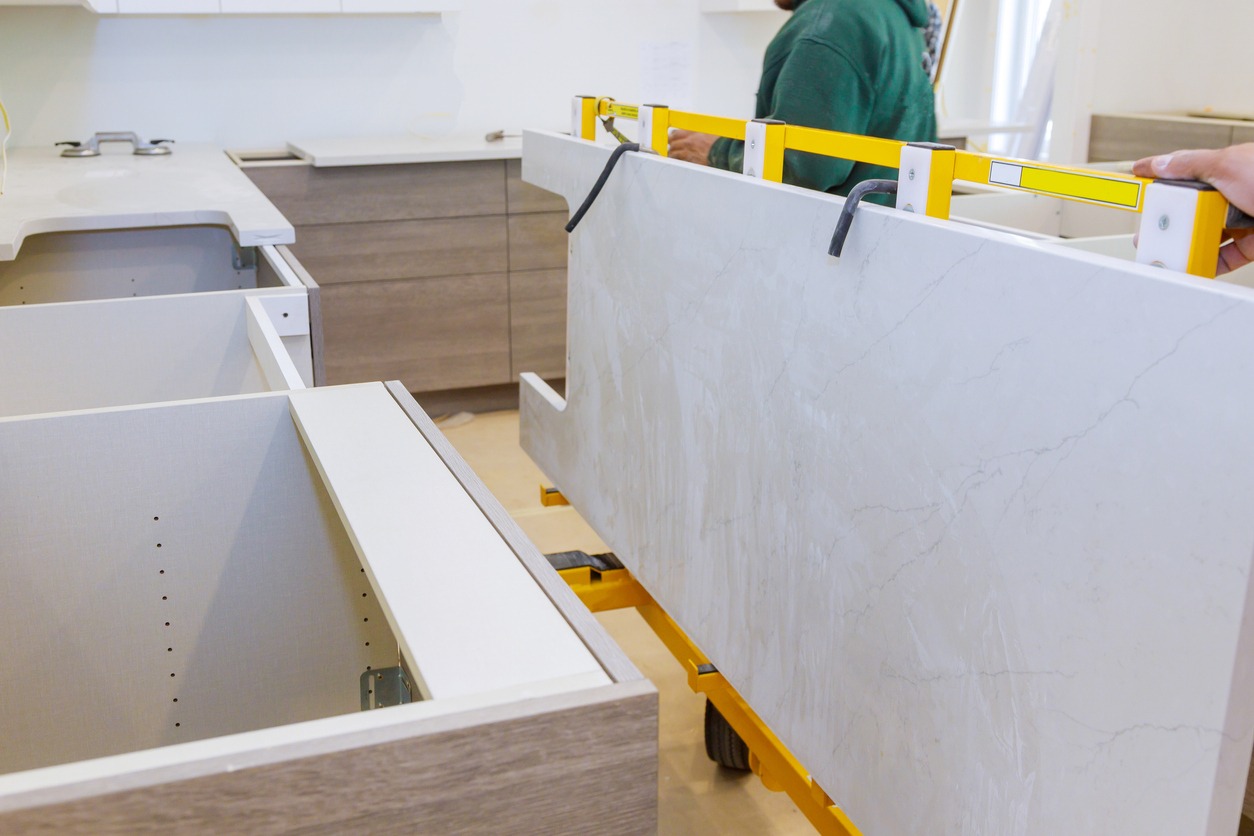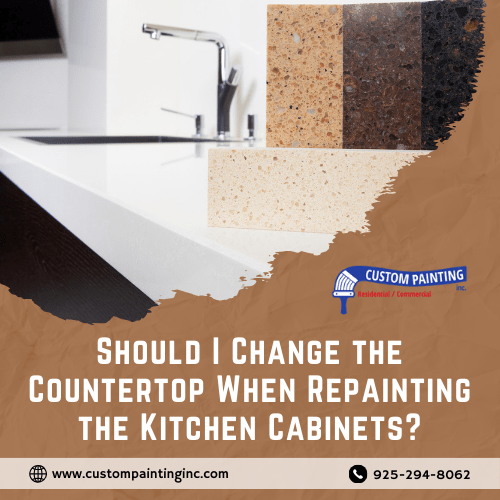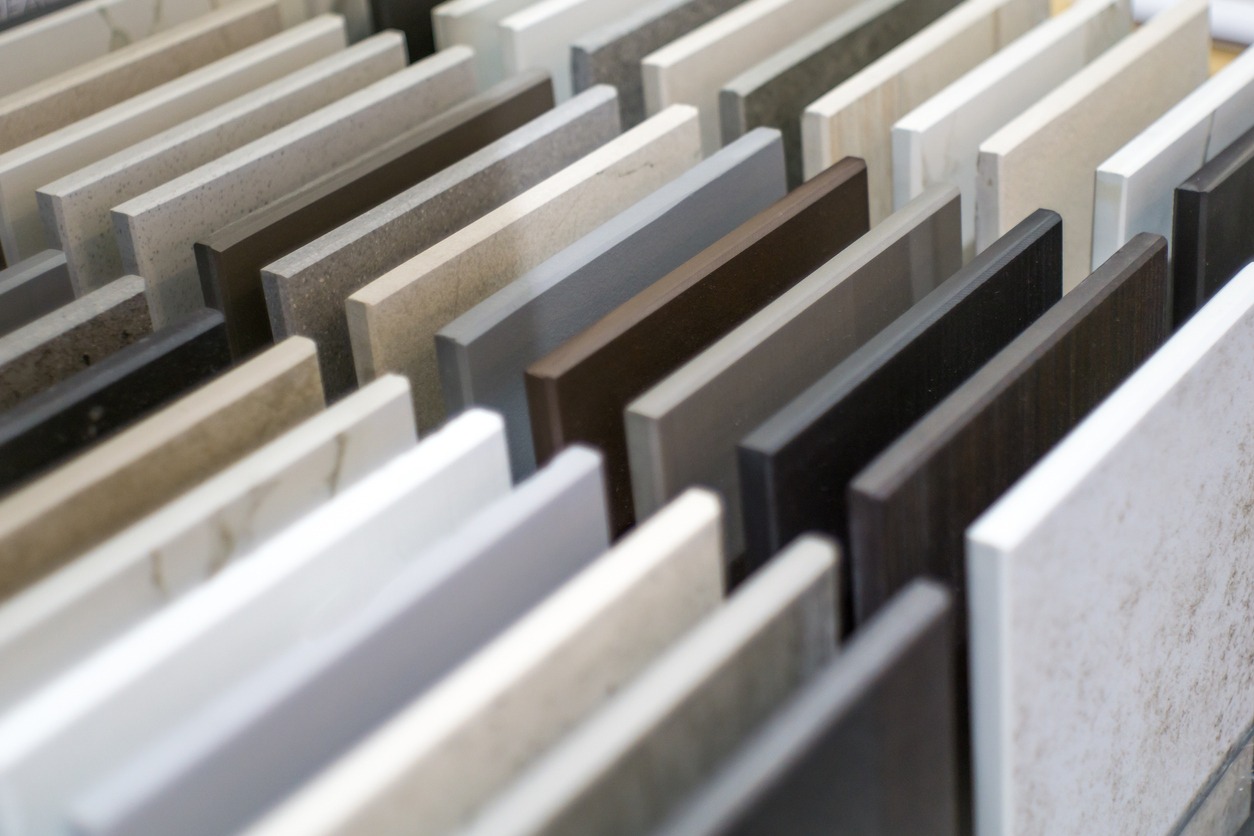Renovating a kitchen is a big decision for any homeowner. One common question that arises is whether to change the countertop when repainting the kitchen cabinets.
Some believe that a fresh coat of paint on the cabinets is enough to revitalize the space, while others argue that updating the countertop is a necessary step for a complete makeover. Read on as we talk about the pros and cons of changing the countertop during a kitchen cabinet repainting project.
Benefits of Changing the Countertop
Here are some benefits of updating your countertop when repainting your kitchen cabinets.
Improved Aesthetics
A new countertop can instantly upgrade the appearance of your kitchen. It can provide a fresh and modern look that complements the newly painted cabinets. Choosing a countertop material and color that harmonizes with your cabinets can create a cohesive and appealing design.
Increased Home Value
Updating your countertop can add value to your home. Potential buyers often look for modern kitchens with high-quality finishes. A new countertop made of granite, quartz, or other durable materials can make your kitchen more attractive to buyers and potentially increase your home’s market value.
Better Durability
New countertops are often more durable and easier to maintain than older ones. Modern materials like quartz are resistant to scratches, stains, and heat. This means your kitchen will not only look better but will also be more functional and easier to clean, making your cooking experience more enjoyable.
Enhanced Functionality
A new countertop can improve the functionality of your kitchen. You can choose a design that offers more workspace or integrates features like built-in cutting boards or integrated sinks. This can make cooking and cleaning more efficient and enjoyable.
Customization Options
When you change your countertop, you have the opportunity to customize your kitchen to better suit your needs. You can select materials, colors, and finishes that reflect your personal style. Customizing your countertop can help you create a kitchen that feels unique and tailored to your preferences.
Considerations Before Changing the Countertop

Before deciding to change your countertop, there are several important factors to consider. These are the key points to think about before making your decision.
Budget Constraints
Changing a countertop can be a costly endeavor. It is essential to evaluate your budget and determine how much you are willing to spend. Countertop materials vary widely in price, with options like granite and quartz typically being more expensive than laminate or tile. Make sure to factor in installation costs and any additional expenses that may arise.
Material Choices
The type of material you choose for your new countertop will affect both the look and functionality of your kitchen. Different materials have different benefits and drawbacks.
For example, granite is durable and heat-resistant, but it requires regular sealing. Laminate is affordable and easy to maintain, but it may not last as long as other options. Consider your lifestyle and kitchen usage when selecting a material.
Compatibility with Cabinets
When changing your countertop, it is important to ensure that it matches well with your existing or newly painted cabinets. The color and style of the countertop should complement the overall design of your kitchen.
If you choose a countertop that clashes with your cabinets, it may not achieve the cohesive look you desire. Take samples of your cabinet paint and potential countertop materials to compare how they look together.
Installation Process
The installation process for a new countertop can be time-consuming and may disrupt your daily routine. It is important to plan for this inconvenience and consider the timing of the project.
If you are working with a contractor, discuss the timeline and any potential issues that could arise during installation. This will help you prepare for any disruptions and ensure a smoother process.
Long-Term Maintenance
Different countertop materials require different levels of maintenance. Some materials, like quartz, are low-maintenance and easy to care for, while others, like marble, require more attention and upkeep.
Consider how much time and effort you are willing to put into maintaining your new countertop. This will help you choose a material that fits your lifestyle and ensures the longevity of your investment.
Types of Countertops to Consider
There are different types of countertops to choose from based on the materials used to make them. Have a look at these popular types of countertops to consider, each with its own advantages and characteristics.
- Granite: Granite countertops are known for their durability and natural beauty. They are resistant to heat and scratches, making them ideal for busy kitchens. Regular sealing is required to maintain their appearance and protect them from stains.
- Quartz: Quartz countertops are engineered from natural quartz and resin, offering a wide range of colors and patterns. They are non-porous and resistant to stains and scratches. Quartz requires less maintenance than natural stone options.
- Marble: Marble countertops provide a classic and elegant look. They are heat-resistant and perfect for baking. However, marble is more susceptible to scratches and stains and requires regular sealing and careful maintenance.
- Laminate: Laminate countertops are a budget-friendly option with a variety of styles and colors. They are easy to clean and maintain, but they can be more prone to damage from heat and sharp objects. Laminate is a good choice for those looking for an affordable and versatile option.
- Butcher Block: Butcher block countertops add warmth and character to a kitchen. They are made from wood and can be sanded and refinished to repair damage. Regular oiling is needed to keep the wood in good condition and prevent drying out.
- Solid Surface: Solid surface countertops are made from acrylic or polyester resins. They offer a seamless look and can be easily repaired if scratched. These countertops are available in many colors and patterns and are non-porous, making them resistant to stains and bacteria.
Matching Countertop with Cabinet Colors
Choosing the right countertop to match your cabinet colors can create a harmonious and stylish kitchen. Here are some tips to help you make the best choice.
- Consider Contrast: A contrasting countertop can make your cabinets stand out. If you have dark cabinets, consider a lighter countertop to create a balanced look. For light-colored cabinets, a darker countertop can add depth and interest to your kitchen.
- Stick to a Color Scheme: Choose a countertop color that complements your kitchen’s overall color scheme. Look at the undertones of your cabinet paint and select a countertop with similar or harmonious tones. This can create a cohesive and pleasing aesthetic.
- Use Neutral Colors: Neutral-colored countertops are versatile and can match a variety of cabinet colors. Shades like white, beige, and gray are timeless and can easily adapt to different styles. They can also provide a clean and modern look to your kitchen.
- Incorporate Patterns: If your cabinets are solid-colored, consider a countertop with a subtle pattern or veining. This can add visual interest without overwhelming the space. Make sure the pattern complements the cabinet color and overall kitchen design.
- Coordinate with Backsplash: Ensure that your countertop and cabinet colors also work well with your backsplash. A coordinated color palette between these three elements can tie the kitchen together. Consider taking samples of your countertop and cabinet colors when selecting a backsplash.
- Test Samples Together: Always test countertop and cabinet color samples together before making a decision. This allows you to see how they look in your kitchen’s lighting. It can help you avoid clashing colors and ensure a harmonious match.
DIY vs. Professional Installation
When updating your kitchen countertop, deciding between DIY installation and hiring a professional is an important choice. Both options have their pros and cons, which can affect your overall experience and results.
DIY Installation
Taking the DIY route can save you money on labor costs. It allows you to work at your own pace and gives you the satisfaction of completing a project yourself.
However, installing a countertop requires specific skills and tools. If you make mistakes, it can lead to additional costs and frustration. It’s a good option if you have experience with similar projects and feel confident in your abilities.
Professional Installation
Hiring a professional ensures that the job is done correctly and efficiently. Professionals have the expertise and equipment to handle various challenges that might arise during installation.
While this option is more expensive due to labor costs, it provides peace of mind knowing the work is guaranteed. It’s a suitable choice if you prefer a hassle-free process and want high-quality results.
Factors to Consider
When deciding between DIY and professional installation, consider your budget, time, and skill level. If you have a tight budget and enjoy hands-on projects, DIY might be suitable. If you lack experience or have a busy schedule, hiring a professional can save time and prevent potential issues. Assessing these factors can help you make an informed decision that best fits your needs and resources.
Conclusion
Deciding whether to change your countertop when repainting kitchen cabinets involves considering factors like budget, material choices, and the overall look you want to achieve. A new countertop can enhance the aesthetics and functionality of your kitchen. However, it’s important to weigh the costs and time involved in such a project.
If you need professional help, Custom Painting, Inc. offers services related to kitchen renovations. Contact us at 925-294-8062 or fill out our Contact Form to get started.


